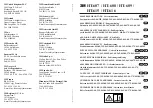
OMH551 OMH553 OMH555
Photoelectric distance sensor
8
5 Installation
5.1 Installation conditions
u
Install the device so that the object to be detected is within the sensor's detection zone.
Reflecting objects in the direct beam path of the sensor – also outside the detection zone – are
to be avoided by the customer (tilt the sensor by 10°). Otherwise the measured values can be
ambiguous.
Detection zone
Ò
Data sheet
5.2 Mounting accessories
The device is supplied without mounting accessories.
Suitable mounting accessories can be found at
5.3 Installation instructions
5.3.1 Avoidance of soiling and ambient light
Preferably align photoelectric sensors with the front lens facing downwards or parallel to the earth’s
surface.
Background:
•
Photoelectric sensors are sensitive to direct radiation of light sources. Everyday light sources
(lamps, sun) radiate from above.
•
Photoelectric sensors react sensitively to soiling, as it reduces the excess gain.
Dust deposits can be reduced by downwards or sideways orientation. This allows for longer
cleaning intervals.
Make sure that sensors installed with their front lens facing upwards are not oriented towards
roof windows or ceiling lamps.
5.3.2 Avoidance of mutual interference
Photoelectric sensors should be installed with a sufficient distance between each other. This
particularly applies if the detection range of the two sensors partly intersects.
The reason for this is:
•
Both sensors have a detection range. This means that the laser light spot of a sensor can be
received by its neighbouring sensor. This may lead to the falsification of the measured values and
result in incorrect switching.
Mutual interference can be avoided by placing the sensors slightly tilted. Align the light spots so
that they impinge as far away from each other as possible.
5.3.3 Sensor alignment for a moving object
The sensor has to be installed in a way to ensure that the object is moved into the detection zone of
the sensor from the side or from the front.









































